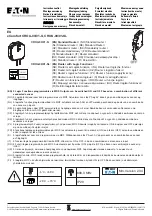
26
27
Technical specifications
Features
Sensor type
Optical smoke detection and thermal detection
Smoke sensitivity
0.115 – 0.168 dB/m
Meets requirements for EN 14604:2005+AC:2008
Heat sensitivity
62°C (+/- 8°C)
Audible alarm
Min 85 dB(A) @ 3m (10'), Frequency: 3.2 kHz
Radio connection
Features a separate radio module inside the smoke detector
Low battery warning
Relays the alarm signal to all Visit receivers with same radio key
within radio range.
Broadcast function
Transmits the smoke and heat alarm to all other Visit receivers
within range, overriding the radio key settings.
Power supply
Battery power
Lithium: 2 x 1.5V AA Energizer Lithium L91
Power consumption
Idle < 15 μA, Active < 75 mA
Operation time
Lithium batteries: 5 years
Radio function
Radio frequency
868.30 MHz
Max output power
4.2 dBm
Coverage
Up to 200 m (218 yd.), clear line of sight.
The range is reduced by walls, large objects and other radio
transmitters such as televisions and mobile phones.
Activation
Via smoke and/or heat and via the test button
Environmental
For indoor use only
requirements
Operating temperature: 4° to 40° C (39° to 104° F)
Transport & storage temperature: -10°C to 50°C (14°F to 122°F)
Humidity range: 15% to 95% RH (non-condensing)
Size and weight
Dimensions:
Ø 120 x 37 mm (Ø 4.7” x 1.5”)
Weight: 150 g (5.27 oz.), including batteries
Receivers may be blocked by radio
signals occurring on or near their
operating frequencies, regardless of
the radio settings.
Radio transceiver equipment should
be tested regularly, at least weekly.
This is to determine, whether there
are sources of interference prevent-
ing communication, that the radio
paths have not been disrupted by
moving furniture or renovations, and
so generally protect against these
and other faults.
This equipment generates, uses and
can radiate radio frequency energy
and, if not installed and used in
accordance with the instructions, may
cause harmful interference to radio
and television reception. However,
there is no guarantee that interfer-
ence will not occur in a particular
installation. If this device does cause
such interference, which can be veri-
fied by turning the device on and off
(by removing the battery) the user is
encouraged to eliminate the interfer-
ence by one or more of the following
measures:
Re-orientate or re-locate the unit.
Increase the distance between the
smoke alarm and the device being
affected.
Consult the supplier or an experi-
enced radio/television technician.
EN
Summary of Contents for BE1481
Page 1: ...BE1481 Visit smoke alarm...
Page 120: ......















































